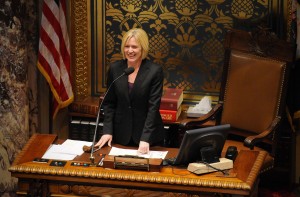- Font Size:
- Default font size
- Larger font size
ST. PAUL — Deficit-plagued Minnesota is spending nearly $4 million in credit line fees over two years to make sure state government doesn’t bounce checks.
Finance officials earlier this summer extended a never-used $600 million line of credit, as state workers prepared for what turned into the nation’s longest state government shutdown in a decade. On Monday, Management and Budget Commissioner Jim Schowalter, the state’s top budget official, said in an interview with The Associated Press that Minnesota might need to borrow against the credit within months to get through at least one tight financial spot.
“It’s going to be close this fall,” Schowalter said in an interview. “We anticipate low balances even this fall and this coming spring, and that’s before we take into account any possible shocks that are going through the system right now.”
The credit isn’t free.
In an era of deep budget cuts, figures from Minnesota Management and Budget show that it will cost $2 million to keep the credit available for another year, through June 2012, even if it’s not used.
That’s enough to sustain higher service levels for anything from legal aid for the poor to early childhood programs — both cut in the latest budget — and it comes on top of $1.8 million spent to open the credit line last year under former Gov. Tim Pawlenty’s administration.
Minnesota isn’t alone in turning to borrowing to make it through tight financial times. States including Arizona and Pennsylvania have turned to banks in recent years as state budgets have been squeezed.
Minnesota hasn’t resorted to short-term borrowing to pay its bills since 1985. But the state has relied on other temporary fixes, including payment delays and accounting shifts, as leaders have grappled with deficit after deficit. The state’s reserves are gone and there’s less than $100 million left in a cash-flow account that serves as a day-to-day financial cushion. The latest budget from Democratic Gov. Mark Dayton and the Republican-controlled Legislature siphoned off nearly two-thirds of the money left in the cash flow account.
That means the credit could be essential in a cash crunch.
Schowalter said the low levels left in Minnesota’s rainy-day funds are “well beyond the comfort zone” and will need to be rebuilt over time. He said he expects the three major rating agencies to look at the state’s cash reserves during meetings next month before the state issues new bonds to pay for construction projects. Minnesota has the top rating from Standard & Poor’s and the second-highest rating from Moody’s Investors Service and Fitch Ratings.
Moody’s cited the diminished rainy-day accounts when it lowered its outlook for Minnesota’s credit to “negative” from “stable” earlier this month. Its report said “significantly strained liquidity” was one factor that could lead it to downgrade the state’s rating. The report said, “... available reserves have been substantially depleted. This leaves the state facing the challenge of addressing ongoing structural imbalance with limited resources in an uncertain economic environment.”
Moody’s also noted that the credit line bolstered the state’s liquidity.
Schowalter exercised the state’s option to extend the credit in a May 31 letter after Gov. Mark Dayton signed off on the move. The extension included nearly $850,000 in closing costs plus $1.2 million in interest. The cost could go up if the state borrows against the credit.
Pawlenty’s administration set up the credit last year after projections showed the state running dangerously low on cash. It originally ran through June without being tapped, while costing the state $1.8 million.
The scramble for money at the Capitol has been fierce in recent budget cycles, as the state has cut spending to deal with repeated deficits.
For example, state-funded legal services that help the poor with everything from eviction defenses to orders for protection for battered women are taking a $1.6 million cut, or nearly 7 percent, over two years. That means more people will be turned away and forced to deal with the courts on their own. And it’s not the first cut to hit the program.
“These are cuts on top of cuts at a time when demand has never been higher,” said Peter Knapp, a law professor who heads a legal services planning committee for the Minnesota Supreme Court.
Schowalter said the cost of the line of credit is part of the state’s guarantee to school districts and other funding recipients that it will make good on its obligations.
Read more: http://www.winonadailynews.com/news/local/article_0a4c3a02-d2bd-11e0-9374-001cc4c03286.html#ixzz1WXO1N6rw


No comments:
Post a Comment